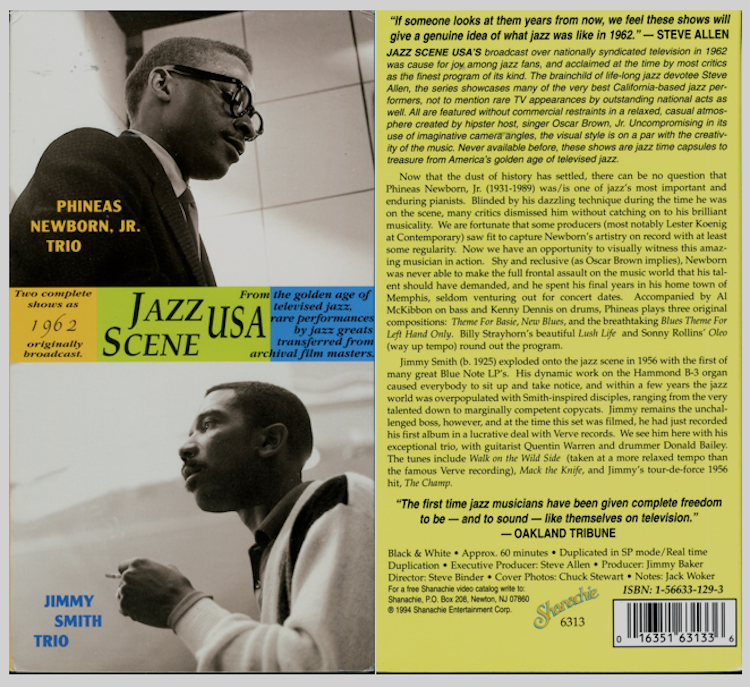JAZZ SCENE U.S.A. #26
JIMMY SMITH TRIO
I am in the process of moving my work on this platform to a new home that unites all of my jazz research under one roof. Thank you for looking at my work here at google blogger. I think you will find the new home more user friendly with links and tags to all of my research. This link will take you to this research at the new site where I have updated the links to Jazz Scene USA segments on YouTube.
MONDAY, NOVEMBER 26, 1962
CBS TELEVISION CITY, LOS ANGELES, CA
Commentary © James A. Harrod, Copyright Protected; All Rights Reserved
The jazz artist selected for the last and 26th program in Steve Allen’s JAZZ SCENE USA syndication series was Jimmy Smith. As noted below in the biographical sketch, Smith had risen in the mid 1950s on the jazz scene and over the course of his recording career with Blue Note Records he had become “the jazz organist” on the American jazz scene. Below are a sampling of his jazz albums from the label.
The Jimmy Smith Trio program was included in the VHS and DVD releases of shows from Jazz Scene USA. It was coupled with the Phineas Newborn, Jr. program and is available at Amazon as well as other internet sites such as Ebay and Half.com.
Jimmy Smith became a jazz innovator when, in the mid-fifties, he revolutionized the sound of jazz organ. Heretofore, Wild Bill Davis had been the pied piper who led many a pianist to the organ with his full orchestral sound and big band emulation. It was Jimmy Smith, however, who gave the organ a new soloing voice in much the same way Louis Armstrong gave new life to the trumpet. Born in Norristown, PA on December 8, 1928, Jimmy revealed his musical talent early. His parents both played piano and encouraged him in the boogie-woogie and stride styles of the day. Jimmy made his professional debut at age fourteen in a father/son dance team and joined the navy a year later to serve in WW II. His GI bill helped him attend Ornstein's School of Music in Philadelphia where his undeniable talent was acknowledged. He studied both piano and bass and admired Art Tatum for technique and a myriad of saxophonists for expression. In 1951, Jimmy joined drummer Don Gardner and his Sonotones but soon felt confined as merely a Rhythm and Blues pianist. Fascinated with the organ, he went to see Wild Bill Davis at the Harlem Club in New Jersey. Jimmy began playing in the style of Bill Davis while with Don Gardner but felt compelled to do more. By 1954, he bought his own Hammond organ and placed it in the warehouse where he and his father worked as plasterers. Every day Jimmy would practice his new ideas on the organ, developing horn lines with never before heard registrations. One day he emerged from that warehouse with a truly original sound. His debut at Spider Kelley's Club drew great approval and in 1956, when Jimmy's trio opened at Greenich Village's Café Bohemia, the word quickly got out that this was, in fact, the new sound in jazz organ.
Jimmy's career advanced rapidly as Blue Note recording sessions fueled his notoriety. He literally became the jazz organist to chase as more and more pianists switched to the organ. Jimmy's trio played the Newport Jazz Festival and the Cannes Festival in France. He added more musicians to his recording sessions as the hits began to compile. Back at the Chicken Shack , The Sermon and Midnight Special all became anthems for budding jazz organists to learn. Television captured the Jimmy Smith experience for Philadelphians in 1961. Downbeat magazine voted him their 'Misc Category' winner in 1962 and by 1963, Jimmy was making commercially successful orchestral recordings for Verve Records.
© Pete Fallico, JJA 2004
Oscar Brown, Jr. promoted two of Jimmy Smith’s LPs on the show, first his Fats Waller album on Blue Note and second the orchestral album with arrangements by Oliver Nelson that included the version of WALK ON THE WILD SIDE that became a chart topper for Jimmy Smith.
The entire Jazz Scene USA show is currently available on YouTube and fans should catch it before it is taken down as frequently happens on the channel.
Jimmy Smith, Hammond B-3 organ; Quentin Warren, guitar and Donald Bailey, drums.
Production credits:
Host: Oscar Brown, Jr.
Executive Producer: Steve Allen
Producer: Jimmie Baker
Director: Steve Binder
Associate Producer: Penny Stewart
Associate Director: George Turpin
Technical Director: Dick Hall
Lighting Director: Leard Davis
Audio: Larry Eaton
Art Director: Robert Tyler Lee
Jazz Consultant: John Tynan
Title Films: Grant Velie
Cameras: Bob Dunn, Ed Chaney, Gorman Erickson, Pat Kenny






















